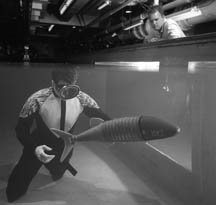
|
Archives:
Spring 2001 Table of Contents
While designing
vehicles that can move gracefully through the water, MIT researchers
turned to the product of millions of years of evolution: fish. These
remarkable swimming machines, which propel themselves with unparalleled
efficiency and maneuverability, have served as models for Ocean
Engineering Professor Michael Triantafyllou and his colleagues at
MIT. Their decade-long effort has yielded a small fleet of autonomous
underwater vehicles--including RoboTuna and RoboPike—that illustrate
a natural route to improved locomotion. There has been one notable
sticking point, however. The artificial sheath used to cover these
replicants—a combination of foam and lycra—is no match
for the real thing. "Fish skin remains smooth, even under severe
flexing," explains Triantafyllou, "and it is superior to any structure
we tried." In 1999, Rosa Azhari—a visiting scientist in Langer's lab who now collaborates from Israel—began studying different types of fish to determine the properties that made the animals so dexterous in the water. Fish are propelled by vigorous lateral bending that puts an inordinate stress on the skin, she learned. "When a fish swims, you can get 180 degrees of motion between the front and back, so you need extreme flexibility to prevent the creation of folds." The synthetic skin used on the robotic fish could not take that kind of abuse, nor did it have the strength to withstand undersea pressures. As a result, small buckles or bulges sometimes formed. "When the surface is no longer smooth, the flow patterns don't match those around a real fish," Azhari says. "You lose a lot of energy and can't reproduce the natural fish motion." Her studies showed that skin is not just a superficial covering, but instead plays a fundamental role in swimming." In subsequent work, Azhari and other Langer lab researchers have grown fish skin on a small scale, employing techniques developed in the lab for growing mammalian tissue. They have worked with different cell lines, including brown bullhead and Chinook salmon strains, feeding the fish cells a "culture media" (consisting of sugar, amino acids, and antibiotics) and placing them on super-thin polymer "scaffolds," which support the nascent skin and give it shape. The investigators were gratified to see that the cultured cells produced some of the same fibrous proteins, like collagen and cytokeratin, that normal fish cells produce. Fish skin is underlain by a web of collagen fibers that is largely responsible for its coveted strength and flexibility. Fish skin synthesis is still at an early stage, notes Roxane Pouliot, a postdoctoral fellow in the Langer lab. "We still don't have real tissue, just clumps of cells roughly the size of a coin." The team has selected a suitable polymer—PEGT/PBT, distributed by a company in the Netherlands—and Pouliot is now doing experiments aimed at selecting the fish cells of choice. The next step will be to scale up production by moving the process from a petri dish to a larger container called a "bioreactor." Growing larger pieces of skin is not a trivial step, adds Azhari, because you have to figure out how to get nutrients and oxygen to all parts of the sample. That requires specially-designed systems for circulating oxygen and food. Once this challenge is solved, others will follow. The team will have to integrate the biosynthetic fish skin with RoboPike or other mechanical structures and then devise a way to maintain the skin. One option would be to keep it alive by providing a steady supply of oxygen and nutrients. That approach seems impractical to Azhari, who favors the option of "fixing" the tissue properties by chemical means—in the same way that properties of leather are fixed after the cells have died. Formaldehyde is a well-known fixing agent, but there are lots of chemicals to choose from. As a result of this research effort, says Langer, "we should learn more about making skin, which could have all kinds of benefits both for humans and fish, while leading to improved robots as well. Although we and others have developed some of the principles used to create artificial skin and other tissues, none of the skins made so far are perfect. And we've never designed artificial tissue for robots before." This project, which involves the melding of animal and machine, "represents an exciting area of future research," he says. |
